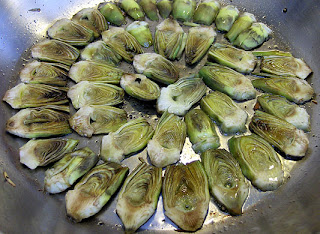Artichokes are considered a culinary delicacy and have been highly prized in
the past. And no wonder when they have so many health benefits. But
what is an artichoke?
The
artichoke is nothing more than a huge, cultivated thistle flower.
Related to the cardoon, globe artichokes (Cynara
cardunculus var. scolymus) are perennial
thistles, developing in their first year and flowering in their subsequent
years. Native to the Mediterranean, and have been cultivated in Sicily
since the time of the ancient Greeks. They derive their name from the Italian
word ‘articiocco’, which comes from the Ligurian word ‘cocali’ meaning pine
cone.
The huge, seasonal artichoke heads sold in the supermarket look exotic, with no obvious part of it that looks remotely edible. The edible part is hidden away inside and without a point in the right direction; you are like to give up trying to find it after you’re the first bitter taste of an artichoke petal.
The edible artichoke that we eat is the unopened flower of the plant. The heart is the most delicious part and the only piece that is truly coveted by the gourmet chef. The bases of the outer petal are also particularly nice, and are traditionally eaten along with a tasty, creamy dip.
.
The
petals themselves are bitter tasting and inedible. However, once cooked
in boiling water, these petals easily peel away from the
base of the flower head. At the base of the removed petal is a tiny morsel of
delicious artichoke heart.
.
 Unless
the artichoke is very small, you will definitely want to avoid the hairy choke.
When left to mature on the plant,
these hairs go on to produce part of the seed body. The taste of the
choke is unpleasant and you will have no alternative that to spit the whole thing out!
The stem is also bitter tasting, except where it attaches to the
heart. On juvenile artichokes you can eat the choke as well as the bottom
half of the inner petals.
Unless
the artichoke is very small, you will definitely want to avoid the hairy choke.
When left to mature on the plant,
these hairs go on to produce part of the seed body. The taste of the
choke is unpleasant and you will have no alternative that to spit the whole thing out!
The stem is also bitter tasting, except where it attaches to the
heart. On juvenile artichokes you can eat the choke as well as the bottom
half of the inner petals.
Artichokes
have more antioxidants in them than any other vegetable. They are rich in
vitamin C, iron and potassium and have been found to reduce cholesterol.
They can improve digestion and a medium artichoke contains more fibre than a
cup of prunes. In addition, they have cancer fighting properties.
There are hundreds of varieties of artichoke to choose from. You can still buy
a few of the old historic varieties such as 'Violetta di Chioggia', and 'Gros
Vert de Laon'. The edible flower is produced from the second year
onwards, although some varieties of artichoke can be grown from seed as
annuals.
For related articles click onto:


No comments:
Post a Comment